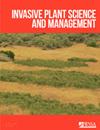Competition reduces structural defense in an invasive thistle in the field
IF 1.2
4区 生物学
Q3 PLANT SCIENCES
引用次数: 0
Abstract
Invasive thistles reduce the productivity of pastures and rangelands because their structural defenses make them unpalatable to grazing livestock. However, plants potentially alter their growth patterns, including their allocation of resources to defense, in response to the presence of competing vegetation. Understanding the effects of competition on the structural defense of problematic pasture weeds can inform management plans that reduce the economic harm caused by these pests. We grew竞争降低了野外入侵蓟的结构防御能力
入侵的蓟马会降低牧场和牧草地的生产力,因为它们的结构性防御使放牧的牲畜无法食用。然而,植物可能会因竞争植被的存在而改变其生长模式,包括将资源用于防御。了解竞争对问题牧场杂草结构防御的影响可以为管理计划提供信息,从而减少这些害虫造成的经济损失。2017 年,我们在一个废弃的单一牧场中进行了一项全交叉因子田间试验,种植了 Carduus nutans L.,其中有两个实验因素:蓟属植物的侵扰程度(1 株或 5 株,导致密度为 4 或 20 株 m-2)和放牧的存在与否(通过每周修剪竞争植被来模拟)。我们通过计数叶片上 3 毫米长的刺来评估处理对防御的影响。我们的分析将叶龄和叶片大小作为协变量。竞争会减少叶片上的皮刺数量。回归分析表明,例如,在 50 x 50 厘米的研究小区内,竞争植被从 50 克增加到 200 克,平均长度为 25.5 厘米的中龄叶片上的皮刺平均数量就会减少 76.9 根/叶,即减少 41%。尽管最老的叶片上的皮刺数量通常少于较嫩的叶片,但所有年龄段的叶片上的皮刺数量都差不多。我们没有观察到与同种植物相邻的植物和与其他竞争者相邻的植物在防御结构上的差异。我们以前曾用高密度的食草动物来管理Carduus nutans,这种做法可能更容易损害防御能力较弱的个体,比如我们在竞争处理中观察到的那些个体。这一发现表明,在牧场中保持竞争可能会增加果蝇对放牧的脆弱性。
本文章由计算机程序翻译,如有差异,请以英文原文为准。
求助全文
约1分钟内获得全文
求助全文
来源期刊

Invasive Plant Science and Management
PLANT SCIENCES-
CiteScore
2.20
自引率
9.10%
发文量
24
审稿时长
6-12 weeks
期刊介绍:
Invasive Plant Science and Management (IPSM) is an online peer-reviewed journal focusing on fundamental and applied research on invasive plant biology, ecology, management, and restoration of invaded non-crop areas, and on other aspects relevant to invasive species, including educational activities and policy issues. Topics include the biology and ecology of invasive plants in rangeland, prairie, pasture, wildland, forestry, riparian, wetland, aquatic, recreational, rights-of-ways, and other non-crop (parks, preserves, natural areas) settings; genetics of invasive plants; social, ecological, and economic impacts of invasive plants and their management; design, efficacy, and integration of control tools; land restoration and rehabilitation; effects of management on soil, air, water, and wildlife; education, extension, and outreach methods and resources; technology and product reports; mapping and remote sensing, inventory and monitoring; technology transfer tools; case study reports; and regulatory issues.
 求助内容:
求助内容: 应助结果提醒方式:
应助结果提醒方式:


